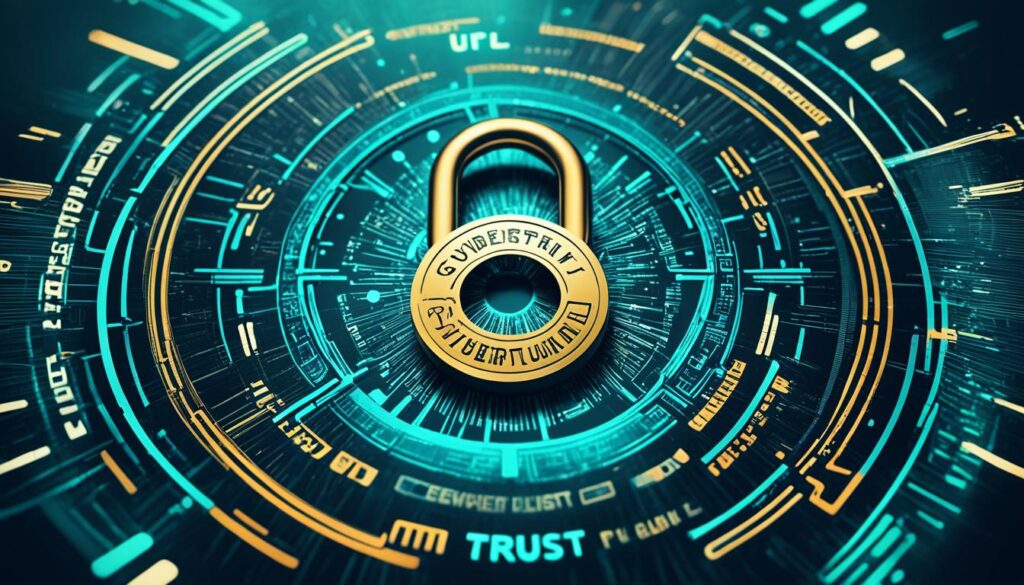Did you know that, as of 2021, over 85% of web traffic was encrypted using SSL/TLS? Behind this staggering statistic lies a complex system crucial for safe online transactions and confidential communications – the certificate chain. This guide serves as an essential resource for understanding certificate chains, integral to maintaining secure web communications in an era where cyber threats are ever-increasing. Whether you’re a seasoned IT professional or just starting to unravel the mysteries of web security, grasping the concept of certificate chains is a key step towards a safer internet experience.
Key Takeaways
- Understanding certificate chains is fundamental for secure user experience and data protection.
- Certificate chains utilize a trust model to validate website security, crucial for avoiding online threats.
- A solid grasp of how digital certificates work helps in recognizing trustworthy web entities.
- This guide simplifies the complexities of certificate chains, promoting enhanced web security literacy.
- Being informed about certificate chains contributes to safer browsing and informed digital decisions.
The Basics of Certificate Chains and How They Work
The foundational security framework of the internet rests largely on digital certificates, key components in establishing secure connections between web services and users. In the realm of SSL certificate validation, understanding the role of certificate chains is crucial. A certificate chain refers to a hierarchy of certificates, beginning with the end-entity certificate of the website, extending through one or more intermediates, and culminating at a trusted root certificate authority (CA).

When you navigate to a secure website—indicated by HTTPS—the server presents its SSL certificate to your browser. This initiates an intricate SSL certificate validation process, which involves verifying the presented certificate against a list of trusted CAs. Modern browsers and applications are equipped with a pre-installed set of trusted root certificates. These entities are the gatekeepers of web security, anchoring the trust that digital communication is built upon.
If at any point in the certificate chain there is a discrepancy—such as an expired certificate, a signature mismatch, or an unrecognizable CA—the trust chain is considered broken. This break prompts the browser to present a security warning to the user, underscoring the necessity of maintaining a valid certificate chain. Such warnings can often indicate an attempt to intercept or manipulate the data being exchanged, a tactic commonly employed in phishing attacks or other malicious activities.
While most digital certificates that users encounter on the web are public and verified by globally recognized CAs, private PKI certificates do exist. These are often used within corporate environments where the issuing entity is trusted by users within that specific context. If accessed externally, without proper SSL certificate validation by a public CA, private certificates can result in security alerts. It serves as a stark reminder of the importance of certificate chains in broader web security and why an understanding of them is indispensable for anyone navigating the digital space securely.
Understanding Certificate Chains: A Deep Dive
At the heart of internet security, digital certificates authenticate and establish trust within digital environments. A robust framework like the Public Key Infrastructure (PKI), featuring a tiered certificate authority hierarchy, empowers this trust by assuring users of the legitimacy of their online interactions. Through certificate issuance and encryption, PKI fortifies the confidentiality and integrity of data exchanged across the web.

The Role of Digital Certificates in Internet Security
Digital certificates are critical in ensuring internet security, serving as digital passports for data transmission protection. Each x.509 certificate provides a means for entities to securely communicate, confirming that the sender and receiver in a transaction are who they purport to be. This level of assurance is indispensable in maintaining a protected and authenticated connection where both privacy and integrity are shielded by encryption.
How Certificate Authority Hierarchy Functions
The certificate authority hierarchy consists of a multi-layered structure starting with the trusted root CA at the summit. This hierarchy extends down to intermediate CAs that, in turn, issue end-entity certificates. By layering these trust levels, the hierarchy ensures scalable and manageable distribution of trust, with the trusted root CA acting as the ultimate anchor for internet security. Each layer of this hierarchy is vital in preserving the unbroken chain of trust—a linchpin for official and secure certificate issuance across the globe.
Public Key Infrastructure Explained
Public Key Infrastructure embodies the set of rules, policies, and processes for creating, managing, distributing, and revoking digital certificates. It enables entities to exchange information securely through the use of a public and a private cryptographic key pair that are intrinsically tied to these certificates. PKI encompasses the mechanisms for handling these keys across various applications and platforms, solidifying its role as a crucial framework for a resilient and trustworthy internet security architecture.
Components of a Certificate Chain
The security of any encrypted communication on the web hinges on the interplay of various digital certificates. A certificate chain, often associated with SSL certificate validation, typically includes the root certificate, intermediate certificate, and the end-entity certificate. Here’s an overview of each component and its significance in the certificate hierarchy.
Root Certificates act as the ultimate trust anchors in a certificate chain, providing the foundation upon which trust is built. These are issued by trusted Certificate Authorities (CAs) and are universally recognized by web browsers and operating systems.
Intermediate Certificates serve as intermediaries between the root certificate and end-entity certificates. They bridge the gap, extending the trust of the root certificate to the leaf certificates.
End-Entity Certificates, also known as leaf certificates, are the final certificates in the chain. They are directly associated with the domain name of the website and are what end users interact with during an SSL/TLS session.

| Certificate Type | Role in Certificate Chain | Purpose |
|---|---|---|
| Root Certificate | Establishes the trust anchor | Validates the authenticity of intermediate certificates |
| Intermediate Certificate | Acts as a bridge between root certificate and end-entity certificates | Proves the linkage to a trusted root, extending trust to end-entity certificates |
| End-Entity Certificate | End point of the certificate chain | Provides identity verification for the entity it represents, usually a web server |
The integrity of the SSL/TLS certificate chain is pivotal—it’s what users and systems rely on to authenticate and secure data across the web. Ensuring that each component of the chain performs its role effectively is essential for maintaining the sanctity of digital communications.
Establishing Trust with the Chain of Trust Model
In the digital age, the chain of trust becomes a critical concept for ensuring the security and validity of our online transactions. Utilizing a hierarchy of digital certificates, the model provides a framework for certificate validation, creating a secured pathway from a trusted authority to the end user. This trusted succession assures that a secured website is what it claims to be, offering significant protection against a multitude of security risks.
Validating the Certificate Chain
Certificate validation plays a pivotal role in safeguarding internet communications. This trust verification process involves meticulously checking each certificate’s issuer against the browser’s or application’s store of trusted certificates. Achieving a successful validation not only certifies a website’s legitimacy but is also key in detecting any changes or potential breaches within a certificate. In instances where keys may be compromised, swift certificate revocation is necessary, followed by the re-issuance of certificates to re-establish trust with users.
Indicators of a Secured Website
How do users know if the website they are visiting is secure? Web browsers make this identification simpler through palpable trust indicators. A ubiquitous padlock symbol, the presence of HTTPS in the URL, and details regarding the certificate issuer present a trifecta of assurance that the site’s traffic is encrypted and its identity has been authenticated. These indicators stem from a web browser’s ability to recognize a valid and intact certificate chain that ties back to a trusted root authority.
What Happens When Trust Verification Fails?
When a trust verification failure occurs, it triggers a warning within the browser, immediately signaling to the user that there’s a potential security risk. Such warnings can arise from various scenarios, such as an expired certificate, configuration errors, or more nefarious causes like a man-in-the-middle attack. It is paramount that organizations keep on top of certificate maintenance to prevent invalidated trust – regular updates and checks are essential to maintain the security and trustworthiness of a website.

Understanding the nuances of the chain of trust and its impact on online security is vital in today’s internet-reliant world. Establishing a reliable chain of trust through careful certificate validation, identifying secured website indicators, and being aware of the implications of trust verification failure are key to fostering a safer internet for everyone.
The Significance of Root Certificates in PKI
The bedrock of Public Key Infrastructure (PKI) security lies in the effective implementation and maintenance of Root Certificate Authorities (Root CAs). These pivotal entities not only initiate a certificate chain but also serve as the authoritative trust anchor for countless digital transactions and communications across the globe. Here, we delve into the responsibilities and challenges associated with Root CAs in sustaining the bedrock of digital trustworthiness.

Root Certificate Authority: The Keystone of Trust
The integrity of a Root CA is paramount, for it is the foundational element that is implicitly trusted within internet security frameworks. Not only do Root certificates assist in authenticating identities and facilitating encrypted exchanges, but they also underscore the critical concept of private key security. It is through rigorous protection of these private keys that a Root CA reinforces its role as the keystone of trust.
Implications of Compromised Root Certificate Private Keys
When the unthinkable occurs—a compromised root certificate—the ramifications echo throughout the digital spectrum. The breach of a Root CA’s private key equates to a break in the fortress of trust, potentially compromising the integrity of every subordinate certificate that falls within its lineage. The breach is a direct threat to PKI security, and immediate remedial steps are essential to prevent the erosion of digital confidence.
Maintaining Integrity and Security of Root Certificates
Proactive and relentless efforts in integrity maintenance of Root certificates are central to a robust PKI system. Root CAs are equipped with precise protocols and advanced cryptographic measures to thwart security breaches. These strategies are crucial for sustaining the stout shields of digital security and the uninterrupted flow of trusted communications.
| Aspect of Root CA Security | Risk Factors | Mitigation Strategies |
|---|---|---|
| Private Key Protection | Theft or unauthorized access | Secure cryptographic storage, limited access protocols |
| Integrity of Certificate Chain | Compromised intermediate or end-entity certificates | Rigorous issuance practices, ongoing surveillance, and validation checks |
| Trust Anchor Maintenance | Expiry or revocation of certificates | Regular updates to root store, efficient distribution of trusted root updates |
Certificate Validation Process and SSL Connection Establishment
The underpinnings of a secure SSL connection hinge on a meticulous certificate validation process, which ensures the authenticity and integrity of the digital handshake between a user’s browser and the web server. The cornerstone of this process is a certificate signing request (CSR), a pivotal step in obtaining a valid SSL certificate. This component carries the server’s public key and identity information, such as its domain name and company details.
When a user attempts to connect to a secured server, the browser retrieves the server’s SSL certificate and embarks on a series of checks to validate its legitimacy. The certificate must bear the digital signature of a trusted Certificate Authority (CA), confirming that the CA has indeed vetted and authorized the entity submitting the CSR. This trust chain is fundamental for establishing a secure connection, as depicted in the intricate steps below:
- The browser or client receives the SSL certificate from the web server upon connection initiation.
- It verifies that the received certificate is signed by a trusted CA present in the browser’s trust store.
- Certificate details are scrutinized, ensuring the certificate has not expired, is not revoked, and is relevant for the requested domain.
- Authentication is established once the browser can securely link the server’s certificate to the trusted CA, completing the SSL handshake.
Failing any part of this validation leads to the browser rejecting the SSL connection, prompting a security warning to the user. The following table provides insights into essential elements scrutinized during the validation:
| Validation Element | Description | Impact on SSL Connection |
|---|---|---|
| Digital Signature | Verification that the CA’s signature is genuine and valid. | Ensures the certificate comes from a trusted source. |
| Certificate Expiry | Checking the validity date range of the certificate. | Guarantees the certificate is active. |
| Domain Match | Ensures the certificate is issued for the domain in question. | Aligns the secured domain with the requesting user’s endpoint. |
| Revocation Status | Ascertains the certificate is not revoked and is in good standing. | Prevents the use of compromised or illegitimate certificates. |
The integral process of certificate verification safeguards users, serving as a bulwark against fraudulent and unsecured web interactions. It underscores the indispensable nature of a validated SSL certificate in maintaining secure, encrypted connections across the vast landscape of the internet.
Deciphering the Role of Intermediate Certificates
Striking a crucial balance in the hierarchy of digital trust, intermediate certificates serve pivotal roles in reinforcing certificate chain security. These entities, functioning within the scope of defined key usage, act as essential conduits between the authoritative root and the responsive end-entities. Let’s explore their distinction from root certificate authorities and why their existence is indispensable for enhancing security protocols.
Intermediate vs. Root Certificate Authorities
In the realm of PKI, Root Certificate Authorities (CAs) are entrusted as the ultimate arbiters of trust. This high level of trust, while powerful, also implies a greater risk if compromised. That’s where intermediate certificates come into play. They are pivotal in ensuring the integrity and security of a certificate chain without direct root CA exposure. These intermediate certificate functions are designed to bolster security by allowing the root CA to remain offline, thereby reducing the risk of direct attacks on the most trusted component of the PKI.
Why Intermediate Certificates are Essential for Security
Intermediate certificates carry specific key usage extensions that define and restrict their abilities to operations like encryption, digital signature validation, and certificate signing. These tightly regulated capabilities are crucial for maintaining a secure network of trust. The strategic issuance of intermediate certificates by a root CA creates a buffer, an essential layer of security enhancement that also lends greater flexibility and extensibility to digital certificate management. By shouldering the operational load, they permit the root CA to preserve a low profile, thereby shoring up the resilience of certificate chain security.
End-Entity Certificates and Their Importance
The digital key to ensuring secure online interactions, the end-entity certificate, is crucial for robust end-entity authentication. These certificates serve as the last link in the certificate chain, directly associated with the server certificate, which facilitates SSL encryption for secure communication between clients and servers.
Functioning as digital passports for online entities, end-entity certificates guarantee that the party presenting the certificate is the one that was authenticated by the Certificate Authority (CA) at issuance. This level of validation is paramount for users when they navigate through the encrypted realms of the internet, confirming that their data is being transmitted securely and to the intended recipient.
End-entity certificates perform a range of essential roles which underpin every secure transaction on the web:
- Certify the identity of the domain or organization to prevent impersonation.
- Initiate secure SSL sessions through handshake protocols.
- Enable encrypted communications, protecting sensitive data from eavesdroppers.
Understanding these roles help grasp the vital nature of these certificates in a digitally interconnected world. Let’s dive deeper into the elements of an end-entity certificate:
| Element | Description | Importance |
|---|---|---|
| Subject Name | Contains identifiable information like domain name | Verifies the website’s legitimacy |
| Public Key | Works with a corresponding private key to enable encryption | Crucial for securing data in transit |
| Issuer’s Signature | Proof that the CA has authenticated the entity | Establishes trust within the certificate chain |
| Validity Period | Specifies the duration of certificate’s validity | Ensures timely renewal and ongoing security |
| Serial Number | Unique identifier for each certificate | Aids in managing and revoking certificates |
The significance of an end-entity certificate can’t be overstated, with its implications stretching far beyond just encryption. It is an emblem of trust and authentication in the SSL protocol, a testament to security and a lynchpin in the overarching structure of internet safety. Amongst cybersecurity measures, it executes its duty silently yet effectively, endorsing the integrity of countless transactions and communications every day.
Behind every secured connection is an end-entity certificate, assuring users that their online experiences are safeguarded against the prying eyes of the digital world.
Revocation and Renewal: Maintaining the Validity of Digital Certificates
The integrity of secure online communication hinges on the reliability of digital certificates. To ensure continued protection and a refresh of trust, mechanisms such as certificate revocation and certificate renewal are imperative. These processes guard against the exploitation of outdated or compromised certificates, thus preserving the digital certificate validity essential for secure transactions.
Understanding Certificate Revocation
Certificate Authorities are tasked with the responsibility to maintain a trusted digital environment. Certificate revocation is a critical security measure taken when a certificate is deemed no longer reliable. Whether due to compromise, affiliation changes, or CA-initiated measures, revocation is key to mitigating potential threats and ensuring that only current and legitimate certificates are active.
When trust is compromised, so is security. Timely revocation is the barrier that keeps threats at bay.
Refresh of Trust: How Certificate Renewal Works
Akin to the necessity of renewing a driver’s license, certificate renewal is the procedural step taken to reestablish valid credentials. Upon approaching its expiry date or if the certificate is revoked, renewal becomes critical. This process involves revalidating entity details and issuing a new certificate, thereby ensuring an unbroken chain of trust and maintaining the seamless flow of secure communications.
The table below offers a comparative glance at certificate revocation and renewal:
| Action | Purpose | Trigger | Outcome |
|---|---|---|---|
| Certificate Revocation | To invalidate a certificate that is compromised or otherwise untrustworthy | Compromise, CA requirements, or changes in certificate details | Removal of certificate from the trusted list, preventing its further use |
| Certificate Renewal | To extend the validity of a digital identity | Expiring certificates or post-revocation procedures | Issuance of a new certificate, continuation of secure communication |
- Revocation is a reactive security measure; renewal is proactive maintenance.
- Both serve to uphold the digital certificate validity crucial for secure online environments.
As digital landscapes evolve, maintaining certificate veracity through revocation and renewal is increasingly essential. This continuous refresh of trust solidifies the foundations of internet security and fosters confidence in digital interactions.
Configuring Certificate Chains for Different Services and Applications
For ensuring secure connections across various platforms, configuring certificate chains for diverse services and applications is essential. A proper configuration aligns with the requisite security protocols and user environment criteria, offering a seamless experience for the users. Below is a step-by-step guide to effectively set up certificate chains.
- Identify the trusted root certification authorities (CAs) for your targeted service or application environment.
- Obtain end-entity/leaf certificates from a CA that chains back to the trusted root CA.
- Ensure the intermediate certificates are properly installed and linked to create a complete path from the end-entity certificate back to the trusted root CA.
- Verify the chain for any discrepancies that could lead to failures in trust validation.
- Configure your server or application to present the full certificate chain during SSL/TLS handshakes.
In practical terms, here is how a certificate chain is generally structured:
| Certificate Type | Position in Chain | Purpose | Issued By |
|---|---|---|---|
| Root Certificate | Top | Establishing Trust Anchor | Self-Signed by Root CA |
| Intermediate Certificate | Middle | Creating a Trust Link | Root CA or another Intermediate CA |
| End-Entity Certificate | Bottom | Identity Verification | Intermediate CA |
Deploying a certificate chain correctly is a critical factor in the process of configuring certificate chains for use with applications and services. This ensures that clients and browsers effectively validate the chain, fostering trust and secure interactions.
Note: Always keep certificate chains up-to-date to maintain security standards and ensure compliance with the constant evolution of technology and threats.
Implementing a robust certificate chain configuration process is indispensable for the integrity and reliability of secure communications. By following these guidelines, services and applications can establish a foundation of trust, necessary for protecting user data and enhancing the overall experience with your platform.
Conclusion
The journey to understanding certificate chains is as integral to secure digital communication as the foundations upon which skyscrapers rest. This bedrock, composed of a harmonious interplay between root, intermediate, and end-entity certificates, ensures the safe and reliable exchange of data across the nebulous frontiers of the internet. By internalizing the structure and stewardship of these chains, we inoculate our digital interactions against the vulnerabilities that lurk within the cyber expanse.
In the realm of secure web communications, the diligence with which these interlinked certificates are handled echoes the grandeur of their significance. Just as the vigilant lighthouse guides vessels through treacherous waters, so does the chain of trust model navigate us through potential online hazards. Each link in the certificate chain binds the next with an assurance of integrity, painting a mosaic of trust that supports the swath of our digital engagements.
Therefore, the mastery of how certificate chains function is pivotal not only to IT professionals but to anyone who traverses the virtual landscapes. The security, reliability, and compliance of our online activities are contingent upon the sanctity of these digital bonds. As the guardians of this digital dominion, let us tread with enlightened steps, empowered by our unwavering dedication to safeguarding the bastion of secure digital communication.
FAQ
What is a certificate chain?
A certificate chain is a sequence of digital certificates that includes a root certificate, one or more intermediate certificates, and an end-entity certificate. This chain enables secure web communications by establishing a trust path that verify the authenticity of the website and its encryption.
How do certificate chains work?
Certificate chains work by allowing a web browser or client to verify that an end-entity certificate, usually presented by a website, is trustworthy. This is done by checking the digital signatures of each certificate in the chain up to the root certificate, which the browser inherently trusts. Each certificate in the chain is signed by the authority above it, up to the root CA, which is self-signed.
Why are digital certificates important for internet security?
Digital certificates are crucial for internet security because they provide a way to establish the authenticity and integrity of websites and their content. They ensure that communication between a web browser and server is encrypted and secure, protecting sensitive data from being intercepted or tampered with by malicious parties.
What roles do different types of certificates play in a certificate chain?
In a certificate chain, the root certificate serves as the trust anchor, intermediate certificates function as a bridge between the root certificate and the end-entity certificate, and the end-entity certificate is used to secure communications to a server, such as a web server, and prove its identity.
How can you tell if a website is secured?
A website is secured if it has a valid SSL certificate, as evidenced by trust indicators in the web browser, which include a padlock symbol, HTTPS in the URL, and the option to view certificate details. These signs indicate that the website has been validated by a trusted certificate authority.
What is a Root Certificate Authority?
A Root Certificate Authority (CA) is an entity that issues digital certificates and sits at the top of the certificate hierarchy. It generates and signs the root certificate, which is used as the ultimate trust anchor in the cryptographic validation of SSL certificates.
What happens if a Root CA’s private key is compromised?
If a Root CA’s private key is compromised, the trustworthiness of all the certificates issued under its authority is called into question. This breach can result in revoked certificates and could necessitate the reissuance of many certificates, potentially disrupting the secure communications of numerous websites and services.
What is the role of Intermediate Certificate Authorities?
Intermediate Certificate Authorities serve as the link between the trusted root CA and the end-entity certificates issued to website owners and other entities. They extend the trust established by the Root CA and allow the root to stay offline, increasing the security of the certificate chain.
Why might a certificate be revoked, and what is the impact?
A certificate might be revoked if it is compromised, if the CA that issued it is no longer trusted, or if there is a change in the information that the certificate vouches for. Revocation is critical to prevent the continuation of trust in a certificate that is no longer secure or accurate, thus maintaining the integrity of secure communications.
How does the certificate renewal process work?
The certificate renewal process involves generating a new key pair and submitting a new certificate signing request (CSR) to a Certificate Authority. The CA validates the identity of the requestor and issues a new certificate, ensuring ongoing trust and secure communications.
How are certificate chains configured for various services and applications?
Certificate chains are configured according to the specific security requirements of different services and applications. The chain must be ordered correctly, linking the end-entity certificate to the trusted root certificate. This setup ensures that digital communications are recognized as secure across diverse platforms.





